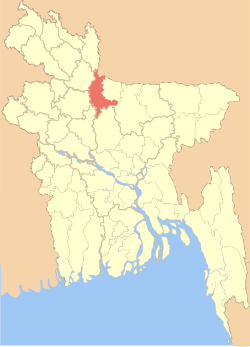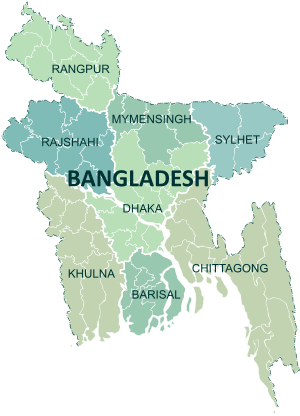Jamalpur District
| Jamalpur জামালপুর | |
|---|---|
| District | |
| Nickname(s): Mymensingh Division | |
 Location of Jamalpur in Bangladesh | |
| Coordinates: 24°55′N 89°58′E / 24.92°N 89.96°ECoordinates: 24°55′N 89°58′E / 24.92°N 89.96°E | |
| Country |
|
| Division | Mymensingh Division |
| Area | |
| • Total | 2,031.98 km2 (784.55 sq mi) |
| Population (2011 census) | |
| • Total | 2,292,674 |
| • Density | 1,100/km2 (2,900/sq mi) |
| Demonym(s) | Jamalpuri |
| Time zone | UTC+6 (BST) |
| Postal code | 2000 |
Jamalpur (Bengali: জামালপুর জেলা, Jamalpur Jela also Jamalpur Zila) is a district in Bangladesh,[1] part of the Mymensingh Division. It was established in 1978.
Geography
Jamalpur occupies 2031.98 km².[1] It is located between 24°34' and 25°26' North and between 89°40' and 90°12' East. It shares an international border with the Indian state of Meghalayain the North East. It is surrounded by Kurigram and Sherpur districts in the North, Tangail district in the South, Mymensingh and Sherpur districts in the East, Jamuna River, Bogra, Sirajganj and Gaibandha districts in the West. The main town is situated on the bank of the river Brahmaputra, 140 km (87 mi) north of Dhaka, the national capital.
Main rivers include Ndjamena, Old Brahmaputra, Banal, Hinayana, Hark Eel, Kaiser Reel, Chiropractic Eel, Mariachi Eel, Karaganda Lake, Handbill Lake, Uranium Digi and Merchandiser Digi.
History
The most notable historical events include the Fakir-Sannyasi Resistance (1772-1790), the Indigo Resistance Movement (1829), Famine (1874), the advent of rail (1899), and the War of Liberation in 1971.
War of Liberation
On June 21, 1971, the Pakistani army, in collaboration with the local Razakars, killed 9 people at the Shashan Ghat (cremation centre) at Jamalpur sadar upazila on the bank of the Brahmaputra. Bengali fighters and the Pakistani army on July 31 fought at Kamalpur Pakistani Army Base of Bakshiganj upazila, with heavy losses to the occupation army. In this battle, 35 freedom fighters including Capt. Salahuddin Momtaz, Ahaduzzaman, Abul Kalam Azad were killed. A battle was fought between Bengali troops under Sector Commander Colonel Abu Taher and the Pakistani army on November 13 at Kamalpur of Bakshiganj upazila. Taher was seriously wounded.
The small Pakistani military base at Kamalpur fell on December 4, following heavy attack by rebels lasting 21 days. In this battle, 220 Pakistani soldiers under the command of Captain Ahsan Malik surrendered.
The Jamalpur garrison was commanded by Sultan Ahmed and lasted about a week. Sultan earned renown among the Pakistanis when he refused to surrender to the Indian commander, Hardev Kler, telling him to use a sten not a pen.[2] This front, together with the Rangpur-Bogra front further west, was the only front where Pakistani troops held out during the war. However, on December 10, 1971 they were ordered to withdraw to Dhaka. During this retreat their commander Abdul-Qadir Niazi fell into enemy custody, giving the Bangladeshis and Indians a morale boost.
Attractions
Jamalpur offers multiple attractions. They include:[3]
- Kali Pahadia, a small hill with a temple at the top dedicated to Goddess Kali, a major picnic spot for tourists and locals;
- JSA Stadium, home to football matches; Jamalpur Golf Course, established in 1912 and one of the oldest golf courses in India;
- Jamalpur Locomotive Workshop, housing many heritage locomotive engines
- Death Valley, and the dense jungle frequented by spiritual practitioners for peaceful meditation.
Economy
Jamalpur is a market center for local rice, sugarcane, jute, tobacco and mustard. The town's main exports are jute, tobacco, mustard seed, peanut, leather, egg, pulse, betel leaf and handicrafts. Making nakshi kantha (embroidered quilts) is a traditional occupation.
Transport
The city is connected by road, rail, and river with Dhaka and the rest of the country.[4] It has a railway station and three Dak bungalows.
Demography
The district has a population of 2,292,674 of which 50.8% are female and 49.2% are male, at a density of 2,191 per km².
Subdistricts
The town is divided into seven upazilas & one police I.C
Culture
Folk music is popular in the district. Popular songs include "Gunaibibir Gan", "Jari Gan of Khairun", "Palagan of Rupvan", "Panchali", "Ghetu Gan" and "Meyeli geet" (songs sung by women on the occasion of marriage and Gaye Holud festivals). In the rural areas, various games and sports practiced. These competitions include bull fights, horse racing, Moi (ladder) race, and Lathi Khela (stick game). During the rainy season, boat races are arranged in the Jamuna river. The Garo community perform dances on the 'Bigan Gala' festival.
See also
References
| Wikimedia Commons has media related to Jamalpur District. |
- 1 2 Samar Pal (2012). "Jamalpur District". In Sirajul Islam and Ahmed A. Jamal. Banglapedia: National Encyclopedia of Bangladesh (Second ed.). Asiatic Society of Bangladesh.
- ↑ Cloughley, "A History of the Pakistan Army"
- ↑ "Jamalpur Tourism, Tourist Places to Visit in Jamalpur City". www.jamalpuronline.in. Retrieved 2018-02-14.
- ↑ "About Jamalpur". www.jamalpuronline.in. Retrieved 2018-02-14.
